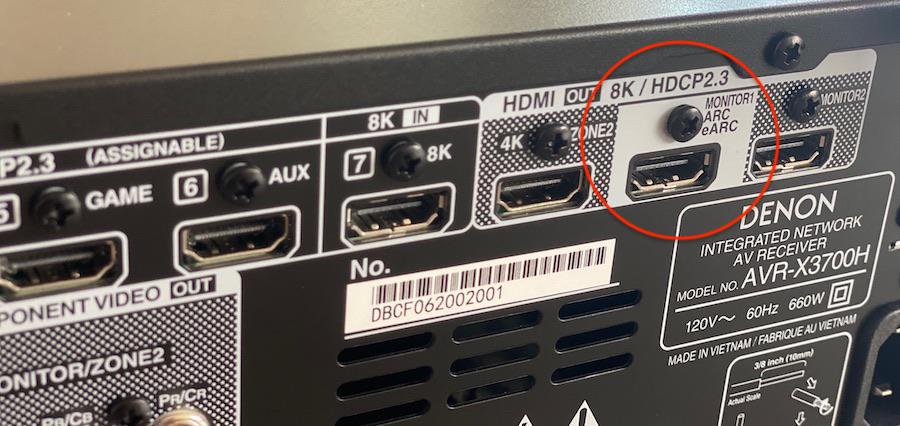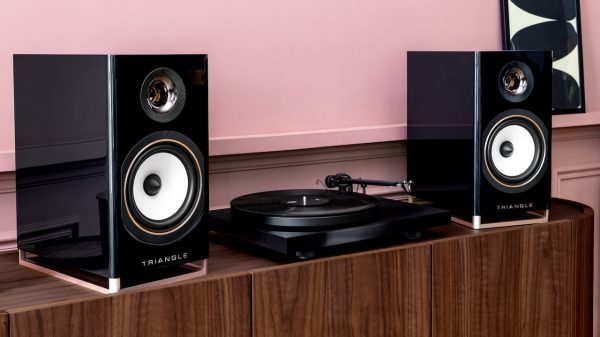Last update: April, 2025, with contributions by Chris Boylan
One of the main limitations with today’s LED/LCD, OLED, QD-OLED TVs and UST projectors is that while they look great, most don’t have a very good built-in speaker system. You need to connect your TV or projector to an AVR, soundbar, or pair of powered loudspeakers if you really want to enjoy sound that’s as good as the picture if not better.
Connecting Audio From Your TV To An External Audio System
Understanding this dilemma, almost all TVs have provided options to connect the TV to an external sound system. Depending on the brand/model of the TV, this can be done via analog stereo or digital optical audio outputs or a newer option called HDMI ARC (audio return channel) or HDMI eARC (enhanced audio return channel).
If you decide to use the Digital Optical audio connection from the TV to an external audio system, compatible formats include two-channel stereo PCM, Dolby Digital/Dolby Digital EX, DTS Digital Surround, and DTS ES.
If you use the analog stereo audio connection option, only two-channel analog audio transfer is supported.

But if your TV and receiver or soundbar was made in the past few years, your best option is HDMI ARC or eARC because these support much higher quality sound than the other two options and simplify the connections quite a bit.
HDMI ARC was first introduced in HDMI ver 1.4 in around 2009, while HDMI eARC was introduced in HDMI ver 2.1 in around 2017. Depending on what HDMI version your TV complies with, you should have either ARC or eARC available over one of the TV’s HDMI ports. HDMI ARC was replaced by HDMI eARC so you don’t have to worry about switching between these two formats.
What HDMI ARC/eARC Does
ARC and eARC allow the HDMI cable connected to a TV and compatible audio system (soundbar, AV receiver, or packaged system) to transfer video in one direction and digital audio in both directions. This means that sources connected to the receiver or soundbar directly can transmit their video signal to the TV over HDMI but also sources connected directly to the TV or streaming services or a tuner built into that TV can deliver their audio signals to the soundbar. With HDMI ARC and eARC, a single HDMI cable is now all that is needed in order to integrate the picture and sound for all connected devices.
Before ARC/eARC, if you had an external source such as DVD/Blu-ray/UHD Blu-ray player, game console, or streaming device connected into an AV receiver, the receiver would send the video to the TV and decode and/or process the audio and send it to your home theater speakers. But you had no way of connecting audio from the TV itself (streaming apps or tuner) back to the receiver or soundbar without using a separate analog or digital audio cable. So audio quality was limited, connections were messy and selecting the right source on both devices could be complicated.
What HDMI ARC/eARC does is eliminate the need for making an extra audio-only analog or digital optical cable connection between a TV and external audio system by using the same HDMI video connection you have already made between the TV and received or soundbar to also pass audio from the TV to the audio system using that same HDMI cable. This results in one less cable connection you have to make between the TV and the rest of your system. It also allows you to pass high quality multi-channel audio in Dolby Digital, Dolby Atmos, DTS Digital or DTS:X format to your sound system via that single HDMI cable.
How To Determine If You Can Use HDMI ARC/eARC
If available on a TV or audio system, HDMI ARC/eARC connections should be clearly labeled. Pay attention because normally only one of the HDMI ports on your TV or receiver supports ARC or eARC. You need to match it up so the ARC/eARC HDMI jack on the receiver or soundbar is connected to the ARC/eARC HDMI jack on the TV or projector. On the receiver, it’s usually labeled HDMI out to TV. On the TV it may be the HDMI 1, HDMI 2 or HDMI 3 port – just look for that ARC/eARC label.

Tip: In order to use either HDMI ARC/eARC, both your TV and external audio system (soundbar, AV receiver) need to be HDMI ARC or eARC equipped. If one device supports ARC and the other supports eARC, that will normally work, but the audio formats will be limited to the lower spec ARC format.
HDMI ARC Capabilities: HDMI ARC can transfer Dolby Digital, Dolby Digital Plus, and DTS 5.1 bitstreams that can be decoded by an external audio system, as well as two-channel PCM. This is similar to what can be accessed via a digital optical connection. However, access to specific formats is provided at the manufacturer’s discretion. Check your TV’s user guide for details.
HDMI eARC Capabilities: For TVs that include eARC, all of the above features and formats of ARC are included, with the added ability to transfer lossless Dolby TrueHD/DTS HD-Master Audio and immersive Dolby Atmos, and DTS:X bitstreams, as well as 5.1/7.1 channel uncompressed PCM audio.
Tip: In some cases, it is possible to transmit lossy Dolby Atmos sound over HDMI ARC if the Dolby Atmos data is encoded on top of a Dolby Digital Plus signal. It depends on the bandwidth of the audio stream and compatibility among devices. But most newer receivers, soundbars and TVs made after 2017 use the newer eARC format which can pass both lossy and lossless versions of Dolby Atmos and DTS:X.

HDMI ARC/eARC and TV Makers
On ARC/eARC-enabled TVs, any compatible audio format originating from the TV or from any source connected to the TV can be transferred to an ARC/eARC compatible external audio system via one HDMI cable connection, provided the TV manufacturer implements all of the eARC features.
HDMI ARC/eARC – Not Always So Easy
Although HDMI ARC and eARC are designed to be quick and easy solutions for sending audio from a TV to a compatible external audio system, there are some inconsistencies based on how TV makers implement this capability.
For example, on some TVs that include HDMI ARC capability, it’s possible that only two-channel audio might be passed through. In other cases, both two-channel and undecoded Dolby Digital bitstreams may be included.
In addition, some TV makers may have only made HDMI ARC active only for over-the-air TV broadcasts. If the TV is a smart TV, it may only be active for the TV’s antenna and internally accessible streaming sources. In some cases, other devices connected to the TV may not pass audio through the TV and out the HDMI ARC port.
As an example, if you connect the audio from a Blu-ray Disc or DVD player directly to a TV, ARC might not pass that audio so you can hear it on your home theater system, or it may only pass two-channel audio but fail to pass through Dolby Digital or DTS bitstreams.
Needless to say, TV makers didn’t do us any favors with inconsistent HDMI ARC feature implementation. However, TV makers that have implemented HDMI eARC include all of ARC and eARC’s capabilities which definitely helps.

HDMI ARC/eARC and CEC
HDMI ARC/eARC is supposed to work in conjunction with HDMI-CEC (Consumer Electronics Control). This provides the additional capability to control volume, mute, device on/off and even basic playback controls of connected devices using the TV’s or the connected device’s remote control.
Typically, HDMI-CEC must be activated on your TV and external audio system before HDMI ARC/eARC can be set up to use. So if you’re having trouble getting sound from your TV to your soundbar or receiver, make sure you have enabled HDMI-CEC in both devices, and set the TV’s sound output to “ARC” or “eARC” external audio device.
Tip: In some cases, ARC/eARC is automatically enabled when HDMI-CEC is activated.
Sadly, glitches can sometimes occur as HDMI-CEC communication features vary among TV, soundbar, home theater receiver and source device makers. But over time, these problems have tended to get less common. It would be nice to be able to use the audio features of ARC/eARC without having to enable HDMI-CEC controls, but that is not currently the case on most equipment.
The Bottom Line
The development of HDMI ARC (good) and HDMI eARC (better) has made connecting TVs to external audio devices like receivers and soundbars simpler than ever. It has also enabled higher quality sound to be sent from compatible TVs and connected devices to a receiver or soundbar. Now you can use your TV as the switcher and send the highest quality audio streams out to an external soundbar or receiver without having to worry about switching multiple devices or juggling remote controls. You can even get Dolby Atmos surround sound from free over-the-air broadcasts if you have an internal or external ATSC 3.0 tuner and compatible local broadcasts.
If you plan to use HDMI ARC or eARC, it is strongly suggested that you read your TV, soundbar and/or AV receiver user guides for details on setup steps and information on what audio formats and sources the TV maker has implemented. In most cases, it “just works” but it helps to be prepared in case you run into any funky compatibility issues.
Related Reading
Buying A New TV: Everything You Need To Know
How To Improve Your TV’s Sound: Don’t Settle For Less
What Is WiSA? What You Need To Know And How It Works
Confused About HDMI 2.1? – What You Need To Know


















































MadMex
November 12, 2022 at 2:50 am
Crack up on every WTF write-up. Very helpful to many readers I suspect, including myself.
Ian White
November 12, 2022 at 2:59 am
MadMex,
It’s good to know that readers find them useful.
Best,
Ian White